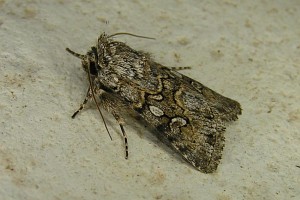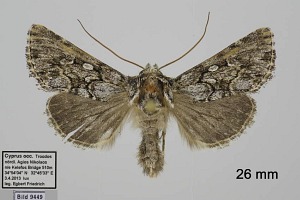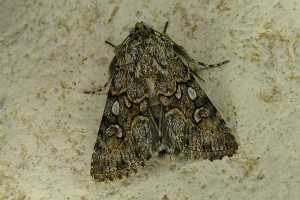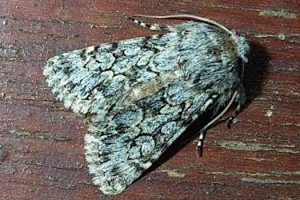

 +7Kontinente:EUAS
+7Kontinente:EUAS1. Lebendfotos
1.1. Falter
2. Diagnose
2.1. Männchen
2.2. Weibchen
2.3. Erstbeschreibung
3. Biologie
3.1. Nahrung der Raupe
- [Plantaginaceae:] Misopates orontium [= Antirrhinum orontium] (Acker-Löwenmaul)
- [Plantaginaceae:] Linaria micrantha ?
Wagner (2019) konnte auf Samos erstmals die Biologie der Art klären und erläutert: "All 16 larvae have been found on Misopates orontium, some of them feeding, a few on blades and stems of other plants next to the hostplant with feeding scars. Additionally, feeding scars of already pupated larvae have been observed in May 2018. In this context, also feed ing scars have been recorded on nearby Linaria micrantha (Cav.) Hoffmanns. & Link, that was already fruiting. It is not sure, however, that the larvae did really feed on this plant, but it is quite probable because in captivity Linaria vulgaris has been accepted."
4. Weitere Informationen
4.1. Etymologie (Namenserklärung)
(die Spitzige).
4.2. Andere Kombinationen
- Acronycta acuta Freyer, [1838] [Originalkombination gemäß Opinion 134 ICZN]
- Pamparama acuta (Freyer, [1838]) [bis Wagner (2019) übliche Kombination]
4.3. Synonyme
- Calophasia producta Lederer, 1857
- Polia pygmaeta Staudinger, 1870
4.4. Taxonomie
Wagner (2019) konnte erstmals die Raupe beschreiben und die Larvalbiologie der Art klären. Dabei stellte er sehr große Ähnlichkeiten mit den Arten der Gattung Calophasia fest. Sein Schluss, dass es besser wäre, Pamparama nicht als getrennte Gattung, sondern nur als Untergattung von Calophasia zu führen, ist gut nachvollziehbar. Er argumentiert: "Life cycle, hostplant, larva, cocoon and most characters of adults and pupa fit well into the genus Calophasia. The only major differences exist in some details of the genitalia and in the pupal cremaster where the toothlike hooks are reduced to two whereas Calophasia usual ly shows four. So one may well agree with the conclusion that Pamparama is a “specialized branch of the Calophasia complex” (Ronkay & Ronkay 1995). But I do not agree that it is really necessary to establish a new genus Pamparama. This is actually a bit subjective in this case (because there are indeed some differences), but in my opinion it is sufficient and most appropriate to transfer acuta (and the other Pamparama species which supposedly do not differ very much) into Calophasia with a subgenus Pamparama: Calophasia (Pamparama) acuta (Freyer, [1838]) (stat. rev., comb. rev.)."
(Autor: Erwin Rennwald)
4.5. Publikationsjahr der Erstbeschreibung
Wir folgen den Ausführungen von Olivier (2000).
4.6. Literatur
- Erstbeschreibung: Freyer, C. F. [1836-1839] („1839“): Neuere Beiträge zur Schmetterlingskunde mit Abbildungen nach der Natur 3: 1-168, pl. 193-288. Augsburg (beim Verfasser).
- Hemming, F. (ed.) (1939): Opinion 134. On the method to be adopted in interpreting the Generic Names assigned by Freyer to species described in his Neuere Beiträge zur Schmetterlingskunde, 1833–1858. — Opinions and Declarations rendered by the International Commission on Zoological Nomenclature 2, Section A: 1-6. London.
- Olivier, A. (2000): Christian Friedrich Freyer's „Neuere Beiträge zur Schmetterlingskunde mit Abbildungen nach der Natur“: an analysis, with new data on its publication dates (Insecta, Lepidoptera). — Beiträge zur Entomologie 50 (2): 407-486. Berlin (Wiley-VCH) [PDF auf zobodat.at].
- Wagner, W. (2019): Calophasia (Pamparama) acuta (Freyer, [1838]) (stat. rev., comb. rev.) — the larva and its ecology in Samos Island, Greece (Lepidoptera: Noctuidae). — Nachrichten des entomologischen Vereins Apollo, N.F. 40 (1): 49–52.

























